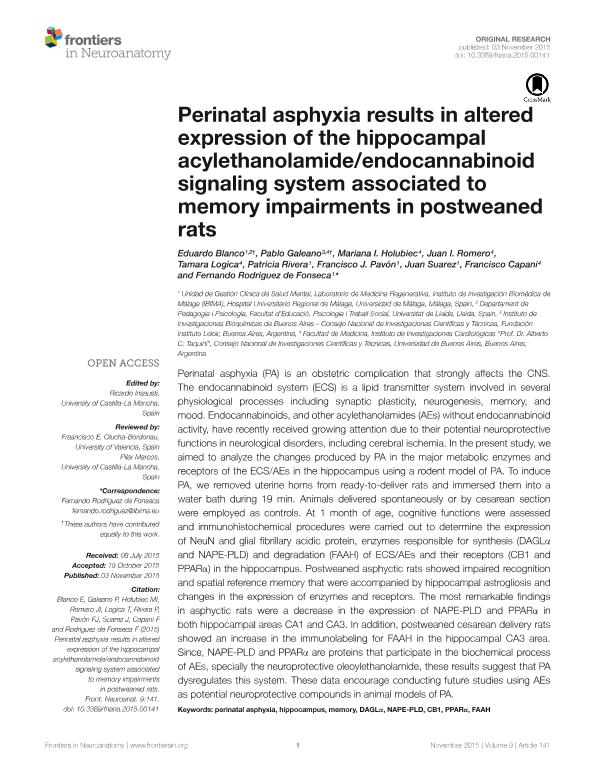Artículo
Perinatal asphyxia results in altered expression of the hippocampal acylethanolamide/endocannabinoid signaling system associated to memory impairments in postweaned rats
Blanco, Eduardo; Galeano, Pablo ; Holubiec, Mariana I; Romero, Juan Ignacio
; Holubiec, Mariana I; Romero, Juan Ignacio ; Logica, Tamara; Rivera, Patricia; Pavón, Francisco J; Suárez, Juan; Capani, Francisco
; Logica, Tamara; Rivera, Patricia; Pavón, Francisco J; Suárez, Juan; Capani, Francisco ; Rodríguez de Fonseca, Fernando
; Rodríguez de Fonseca, Fernando
 ; Holubiec, Mariana I; Romero, Juan Ignacio
; Holubiec, Mariana I; Romero, Juan Ignacio ; Logica, Tamara; Rivera, Patricia; Pavón, Francisco J; Suárez, Juan; Capani, Francisco
; Logica, Tamara; Rivera, Patricia; Pavón, Francisco J; Suárez, Juan; Capani, Francisco ; Rodríguez de Fonseca, Fernando
; Rodríguez de Fonseca, Fernando
Fecha de publicación:
11/2015
Editorial:
Frontiers Research Foundation
Revista:
Frontiers in Neuroanatomy
ISSN:
1662-5129
Idioma:
Inglés
Tipo de recurso:
Artículo publicado
Clasificación temática:
Resumen
Perinatal asphyxia (PA) is an obstetric complication that strongly affects the CNS. The endocannabinoid system (ECS) is a lipid transmitter system involved in several physiological processes including synaptic plasticity, neurogenesis, memory, and mood. Endocannabinoids, and other acylethanolamides (AEs) without endocannabinoid activity, have recently received growing attention due to their potential neuroprotective functions in neurological disorders, including cerebral ischemia. In the present study, we aimed to analyze the changes produced by PA in the major metabolic enzymes and receptors of the ECS/AEs in the hippocampus using a rodent model of PA. To induce PA, we removed uterine horns from ready-to-deliver rats and immersed them into a water bath during 19 min. Animals delivered spontaneously or by cesarean section were employed as controls. At 1 month of age, cognitive functions were assessed and immunohistochemical procedures were carried out to determine the expression of NeuN and glial fibrillary acidic protein, enzymes responsible for synthesis (DAGLα and NAPE-PLD) and degradation (FAAH) of ECS/AEs and their receptors (CB1 and PPARα) in the hippocampus. Postweaned asphyctic rats showed impaired recognition and spatial reference memory that were accompanied by hippocampal astrogliosis and changes in the expression of enzymes and receptors. The most remarkable findings in asphyctic rats were a decrease in the expression of NAPE-PLD and PPARα in both hippocampal areas CA1 and CA3. In addition, postweaned cesarean delivery rats showed an increase in the immunolabeling for FAAH in the hippocampal CA3 area. Since, NAPE-PLD and PPARα are proteins that participate in the biochemical process of AEs, specially the neuroprotective oleoylethanolamide, these results suggest that PA dysregulates this system. These data encourage conducting future studies using AEs as potential neuroprotective compounds in animal models of PA.
Palabras clave:
Perinatal Asphyxia
,
Hippocampus
,
Memory
,
Dagla
,
Nape-Pld
,
Cb1
,
Ppara
,
Faah
Archivos asociados
Licencia
Identificadores
Colecciones
Articulos(IIBBA)
Articulos de INST.DE INVEST.BIOQUIMICAS DE BS.AS(I)
Articulos de INST.DE INVEST.BIOQUIMICAS DE BS.AS(I)
Citación
Blanco, Eduardo; Galeano, Pablo; Holubiec, Mariana I; Romero, Juan Ignacio; Logica, Tamara; et al.; Perinatal asphyxia results in altered expression of the hippocampal acylethanolamide/endocannabinoid signaling system associated to memory impairments in postweaned rats; Frontiers Research Foundation; Frontiers in Neuroanatomy; 9; 11-2015; 1-16
Compartir
Altmétricas



